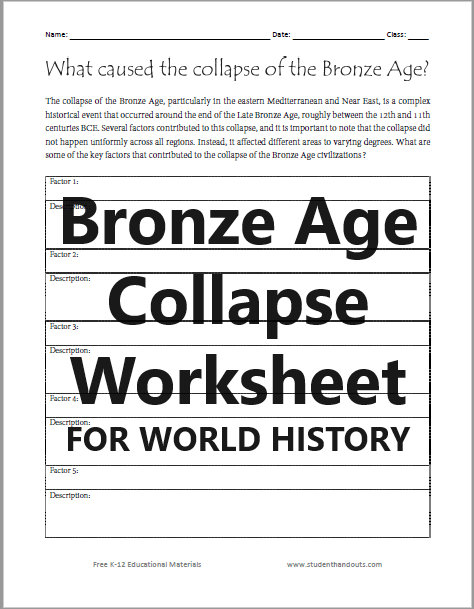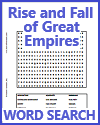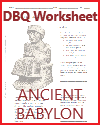| What Caused the Collapse of the Bronze Age? PDF Worksheet |
|---|
| www.studenthandouts.com ↣ World History ↣ Ancient Near East ↣ Ancient Near East Worksheets |
 |
    |
|
Click here to print. Answers will vary.
The collapse of the Bronze Age, particularly in the eastern Mediterranean and Near East, is a complex historical event that occurred around the end of the Late Bronze Age, roughly between the 12th and 11th centuries B.C.E. Several factors contributed to this collapse, and it is important to note that the collapse did not happen uniformly across all regions. Instead, it affected different areas to varying degrees. Here are some of the key factors that contributed to the collapse of the Bronze Age civilizations, which students may list on their completed worksheets. Invasions and Migrations: The arrival of various groups, often referred to as the "Sea Peoples," disrupted existing power structures and kingdoms in the eastern Mediterranean. These groups, including the Philistines, are believed to have invaded and contributed to the downfall of several Bronze Age civilizations. Political Instability: Internal strife, power struggles, and weakened central authority in some city-states and kingdoms contributed to instability and vulnerability to external threats. Drought and Climate Change: Evidence suggests that the late Bronze Age experienced periods of drought and climate fluctuations. Reduced agricultural productivity and resource scarcity could have put stress on societies. Trade Disruptions: Interruptions in long-distance trade networks disrupted the flow of goods and resources. This impacted economies and could have caused shortages of vital materials, such as tin needed for bronze production. Natural Disasters: Archaeological and geological evidence suggests that earthquakes and other natural disasters may have damaged cities and infrastructure. The city of Ugarit, for example, was destroyed in a fire around 1190 B.C.E. Economic Collapse: Economic factors, including overreliance on single industries (e.g., bronze production), may have made societies vulnerable to economic shocks and resource depletion. Social Unrest: Social unrest, possibly exacerbated by economic hardships and political instability, may have contributed to the collapse. Revolts and uprisings could have weakened governing authorities. Influence of External Powers: The expansion of new powers in the region, such as the rise of the Assyrian Empire, could have had an impact on existing political dynamics and contributed to the decline of some states. Decline of Urban Centers: The abandonment or decline of major urban centers and trade hubs is evident in archaeological records. This suggests a breakdown in urban life and governance. Cultural and Technological Changes: Changes in cultural practices, including shifts in religious beliefs, and the transition from bronze to iron as the primary metal for tools and weapons, marked a shift in technological and cultural landscapes. Loss of Writing and Documentation: Some societies experienced a decline in writing and record-keeping, which makes it difficult for historians to fully understand the causes of the collapse. It is important to note that these factors likely interacted and reinforced each other, and their impact varied from one region to another. While some Bronze Age civilizations did indeed collapse, others evolved and gave rise to new cultures and kingdoms. The collapse of the Bronze Age marked a transition period that eventually led to the development of Iron Age civilizations in the eastern Mediterranean and Near East. Upon completion of this free printable worksheet, students should discuss how these various causes were interconnected and reinforced one another, leading to the systemic collapse that defines this period in world history. |
| Ancient Near East Books and Films | Ancient Near East Outlines and PowerPoints |
| Ancient Near East Maps and Pictures | Ancient Near East Study Games |
| Ancient Near East Miscellany | Ancient Near East Worksheets |
| www.studenthandouts.com ↣ World History ↣ Ancient Near East ↣ Ancient Near East Worksheets |








